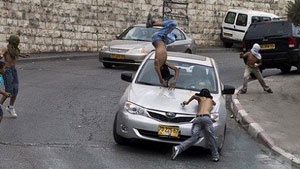The Facts
On Wednesday 22 June, Muhammad MahmoudMahmoud, 12-years-old, was playing hide and seek with his friends in his neighborhood of al-‘Eisawiyya in East Jerusalem. While he was looking for his cousin he saw a group of children being chased by a masked man in military uniform.
Muhammad fled with the other children but was caught by an Israeli soldier and held in a military van. Once in the van, he was told to look at his feet while the soldiers beat him on the neck.
A male witness, ‘Ala’ al-Din Dirbas, who was driving by at the time and knows the individuals involved, sawthe soldiers first capture Muhammad and then put another child, Tamer Mhareb, also 12-years-old, into the van.
Shortly afterwards, ‘Ala’ saw Muhammad’s uncle, Ahmed, on the street and told him that the soldiers had taken his nephew. Ahmed approached and questioned the soldiers.Muhammad later reported hearing his uncle yelling, “That’s my boy!” and then hearing gunshots.
‘Ala’ confirmed that the soldiers physically attacked Ahmed while shooting rounds into the air. Moments later, a soldier shot Ahmed in the thigh from a distance of about ten centimeters. The soldiers then put Ahmed into the van and drove away.
Muhammad reports being taken out of the car in the French Hill neighborhood, which he was able to recognize from under his blindfold, and forced to sit in the sun. After a long wait, the soldiers took Muhammad to the Israeli Police Station in East Jerusalem. His father came to meet him and they went together for questioning.The investigator asked Muhammad for the names of boys who had thrown stones to which he replied that he did not know. The investigator told him to come back the next Friday for additional questioning.
Muhammad was left with mild injuries from the incident, and only later learned that his uncle Ahmed had been shot. (See Al-Haq Affidavits No. 6436/2011 and 6437/2011).
Analysis
This incident is indicative of Israel’s policy of intimidation and collective punishment towards children suspected of throwing stones. As of May 2011, this policy has resulted in 211 children held in Israeli detention.I
n addition to inflicting injury and psychological stress on Palestinian childrenthese operations also violate international law.
The United Nations Convention on the Rights of Children specifies in Article 37(a) that no child should be exposed to cruel or degrading treatment and in 37(b) that arrest, detainment, and imprisonment of children should be used as a measure of last resort.ii
The Fourth Geneva Convention states in Article 76 that “proper regard shall be paid to the special treatment due to minors.”iii Arbitrary arrests, prolonged detainment, and physical assaultinflicted on children by Israeli forces are in violation of these international provisions.
The treatment of Muhammad demonstrates the vulnerability of children in situations of armed conflict. Low-intensity conflicts like that in East Jerusalem take a serious toll on the livelihood of children living in affected areas.iv
Action
Al-Haq calls upon Israeli forces and authorities to halt or reform these operations to reduce their adverse affects on innocent Palestinian civilians, especially children.Al-Haq also reminds the international community of its duty as third state parties to condemn these operations and ensure that Israel conforms to the standards of international law outlined above.
[i] Defense for Children International ‘Child Detainees’ accessed 29 June 2011.
[ii] United Nations Convention on the Rights of Children, Article 37(a) and (b).
[iii Fourth Geneva Convention of 1949, Article 76.
[iv] United Nations Office of the Special Representative of the Secretary-General for Children and Armed Conflict ‘Children and Conflict in a Changing World’ 2006.



 21-28 June
21-28 June